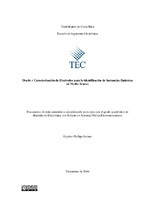Diseño y Caracterización de Electrodos para la identificación de Sustancias Químicas en Medio Acuoso
Abstract
The pollution of water resources has become a major concern of government and
private organizations. Additionally, the gradual decline of this resource recall to protect water
sources that are not contaminated and can be used for human consumption. However, the
accelerated growing of population demanded to extend the farming fields, increasing the use
of pesticides and herbicides. Therefore, the detection of contamination in water sources is
requiring tools that allow “in situ” analysis, at reasonable costs and avoiding chemical
methods that are harmful to the environment.
This document describes the design, fabrication and characterization of a gold microelectrode
coated with PEDOT polymer, for measuring concentrations contaminants that
threaten water sources for human consumption and agricultural purposes.
The capabilities of the electrode were verified by measuring the concentration of
arsenic through cyclic-voltammetry technique, which allows to observe a specific peak of
current for each concentration of arsenic. The experimental results indicated a maximum
sensitivity of the electrode to a solution of arsenic in aqueous medium of 66.7 ug/L and a
linear measurement range from 166.7 ug/L to 1000 ug/L. Furthermore, the measurement was
simulated in COMSOL multi-physics package to compare the experimental results against
theoretical results
Description
Proyecto de Graduación (Maestría en Electrónica) Instituto Tecnológico de Costa Rica, Escuela de Ingeniería Electrónica, 2016.


